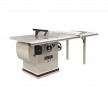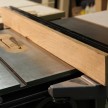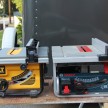RIDGID 10 Inch Table Saw R4510 Review
RIDGID’s R4510 Heavy-Duty 10-inch Portable Table saw with stand
By Tim Curry
As a cabinet maker and carpenter I rely on my table saw to be the work horse of my shop. I am accustomed to having a solid, stable, powerful machine in the shop. When it comes to being on a job site, I need a similar preforming saw but portable. It’s hard to believe that a portable table saw can also be powerful and preform. A table saw’s primary job on a job site is ripp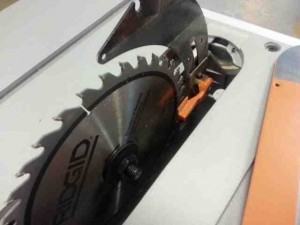 ing. Having a powerful motor, a solid fence, and a solid stable stand, will make a considerable difference on the job site.
ing. Having a powerful motor, a solid fence, and a solid stable stand, will make a considerable difference on the job site.
When I first got into woodworking I didn’t have the money to buy equipment, so my father passed down his old table saw to me. By the looks of it had seen better days. It was passed down to him from his father. I think they called it a portable bench table saw. It was made out of cast iron and surely wasn’t easily portable nor powerful. At that time that is what they called portable. You needed two guys to put it in the back of a truck. I can remember starting it up for the first time. It had a sound all of its own. More like a low groan. The constant vibration of the saw made it move slowly on its own across the smooth concrete.
I remember cutting some ¾ oak and that thing bogging down and sounding like an animal in distress. It was the sound of the belt squeaking and groaning. The smell of burning rubber filled the air. But, I couldn’t complain because I was making sawdust. There were surely saws out there that were far better. I need to get some projects done so I could make some money and buy that all important workshop work horse. That was 25 years ago and since then I have had a few table saws and a few portable table saws.
I recently had the opportunity to review the RIDGID R4510 Heavy Duty portable saw. Once I had it in my shop I unpacked it, set it up and started producing that sweet essence of sawdust.
The setup of the saw stand was fairly quick and easy since the parts were marked clearly with letters. Essentially, A inserts into A type assembly. For the most part, the factory setup was right on out of the box. Other than a quick adjustmen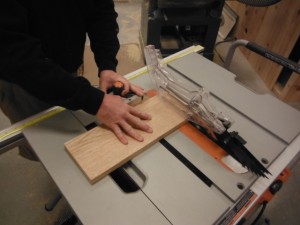 t of aligning the blade parallel to the miter slot it was ready to go.
t of aligning the blade parallel to the miter slot it was ready to go.
Initial impression
My first impressions of this saw were nothing less than RIDGID had surpassed my expectations right out of the gate. This saw is indeed heavy duty. The stand is solid and has a single latch point that can be disengaged with your foot for folding it for transport. The solid wheels make moving it around on any surface seem almost effortless. This stand transitions easily and smoothly up into the locked operating position. I have used other portable table saws and it seemed like you had to wrestle and exert way too much energy to get those stands into its locked position securely where it wasn’t going to collapse on you. The solid stand in combination with the heavy duty saw offers up a very stable platform to help it stay in place while cutting.
Other portable table saws have a tendency to move if you are trying to cut large or heavy material, especially sheet goods. When I first turned on the 15 amp motor I was surprised by how powerful the motor felt. The soft start allowed it to spin up smoothly to its operating RPM. I knew this new saw and I were going to get along just fine.
Overview of the saws functions
I found that the fence was solid and moved smoothly. It has a pressure lock to release and allow it to move freely. There is a micro adjustment for fine tuning the fence’s position. Once positioned, you just engage the pressure lock. The accuracy of the tape measure was right on. I could set the fence perfectly to what I wanted by just lining the indicator on the mark.
The raising and lowering of the blade was also smooth. There is a crank that has a small orange lock knob on its face that will unlock it so you can raise or lower to adjust the blade height by cranking it left or right.
 The tilting of the blade was accomplished by taking the pressure off the tilt lock mechanism. You can then either push on the spring loaded adjustment ring in far enough to clear the gears allowing you to swing and tilt the motor and blade assembly smooth and easily. Or, you can rotate the adjustment ring and fine-tune the bevel angle. Then secure the lock pressure clamp and you’re done.
The tilting of the blade was accomplished by taking the pressure off the tilt lock mechanism. You can then either push on the spring loaded adjustment ring in far enough to clear the gears allowing you to swing and tilt the motor and blade assembly smooth and easily. Or, you can rotate the adjustment ring and fine-tune the bevel angle. Then secure the lock pressure clamp and you’re done.
This saw incorporates safety features such as a removable “key” which will disable the saw if removed. There is a riving knife that will keep the wood from pinching the blade and causing kickbacks. The riving knife can be adjusted to accommodate different thicknesses of stock. There is a lever to release the riving knife allowing you to change the height of it. The pawls keep the material from moving backwards during a kickback. There are spring-loaded buttons which you press to remove the pawls. Finally, the blade guards keep your hands away from the blade. You can remove these guards by pulling up a single lever at the back hinge point releasing them. The guards also have spring clips to keep them up out of the way when needed. Please remember these safety features are designed to keep you safe. Removing them is not recommended.
In order to change the blade or change positions of the riving knife you will have to remove the pawls, blade guard, and table top insert, and then move the riving knife lock lever to the up position. Don’t forget to return the riving knife lock lever to the locking position once you have changed the blade.
All the accessories including the blade guard system, the push stick, the mitre and the blade wrenches ca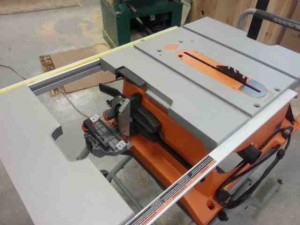 n all be stored on-board the saw.
n all be stored on-board the saw.
Using the saw
I decided to start by ripping some material since that is the primary job of this saw at a jobsite. I kept the blade that shipped with the machine loaded. I wanted to see how the factory setup stood up with general cutting. I went at her by ripping an assortment of ¾” hardwoods. I started off with softer hardwoods, working my up to the harder woods. I used cherry, walnut, red oak, white oak, hard sugar maple, and Hickory. This powerful motor ate right through all of these. There were no issues with any loss of power like some other portable table saws I have used. I decided to increase the thickness of the stock to 6/4 or 1 ½” using the same hardwood species to see how it handled it. I had to raise the riving knife which was easily accomplished by the steps mentioned in the previous section. The riving knife, blade guards, and pawls, did their job with no binding or hampering of the movement of the wood through the machine. When I got into the harder woods the motor worked a little harder but it still had more than enough power and torque to rip through these hardwoods
Next I did some cross cuts using the same sampling of ¾” hardwoods. As expected I had no issues. It preformed just as expected. The Mitre gauge slid smoothly and was easily adjusted to the angle you desire.
I thought if I was going to have any issues with the motor bogging down it would be with a dado set in it. I put in a ¾” dado stack and set it at ½” deep and sent each species of wood samples through it without the motor bogging down. If the motor has to work too hard it will add additional stress reducing its life span. This saw handled it with ease. The sweet sound of those chippers humming through the wood was music to my ears and the smell of fresh cut wood sent me into a woodworkers high.
As anticipated I did not encounter any issues with cutting plywood, MDF, or melamine. You must remember to use the appropriate blade for the type of cut and material you are cutting. Use a ripping blade for ripping and crosscut blade for cro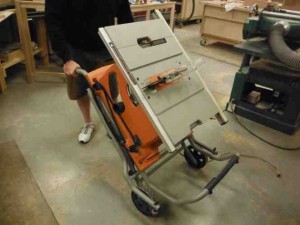 sscuts to get the best results.
sscuts to get the best results.
Features
- SINGLE HEIGHT/BEVEL ADJUSTING HANDWHEEL – includes both quick and micro bevel adjustment with blade height lock
- TOOL-LESS BLADE GUARD – quick and easy installation or replacement with a single action lever
- ANTI-KICKBACK PAWLS – allow for effortless removal and installation independent of the blade guard
- “T” SLOT MITER GAUGE – provides additional capacity for cross-cutting
- IND-I-CUT™ ALIGNMENT DISC – writable surface to accurately align cut line with blade
- MicroJust™ Fence – for best-in-class accuracy
- RETRACT-A-RIP™ SYSTEM – extendable rail and table system that maintains rip dimension accuracy to the blade up to 25 in. rip capacity
- OVER-SIZED ON/OFF SWITCH ASSEMBLY – for easy actuation
- LARGE BEVEL SCALE – for increased accuracy
- 2-1/2 in. DUST PORT – provides connection to standard shop vacuum or dust collection system to help keep work area clean
- ON-BOARD STORAGE – holds rip fence, miter gauge, blade guard assembly, anti-kickback pawls, push stick, extra blades, blade wrenches, and power cord within easy reach for transportation
Specifications
- Input: 120 V AC, 15 Amps
- No Load Speed: 4,400 r/min. (RPM)
- Blade Diameter: 10 in.
- Depth of Cut at 45°: 2 ¼ in.
- Depth of Cut at 90°: 3 1/2″
- Rip Capacity: 25 in. right of blade / 12 in. left of blade
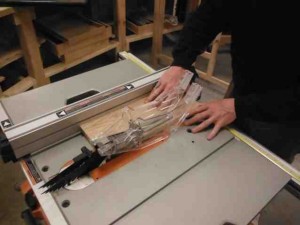
- Weight: 94 lbs
What’s Included:
- Carbide Tipped Blade,
- Anti-Kickback Pawls,
- Blade Guard Assembly,
- Rip Fence,
- Miter Gauge,
- Push Stick,
- Blade Wrenches,
- Operator’s Manual
Overall impression
RIDGID truly surpassed my expectations with the R4510 Heavy Duty 10” portable table saw. It is a solid, stable, powerful, and portable saw that preforms beyond what I expected. Thinking back to that hand me down table saw from my father, it’s hard to imagine how far the woodworking machinery industry has come. This saw is a solid workhorse.
Tim Curry is a licensed contractor, cabinet maker, carpenter, and owner of a custom cabinet and furniture business located in Poynette, Wisconsin; Prairie Woodworks LLC provides fine custom cabinetry and furniture for use in residential and commercial construction. Tim has 20 years of experience in residential remodeling, design, and construction. Tim enjoys evaluating, reviewing, testing tools and making sawdust.




